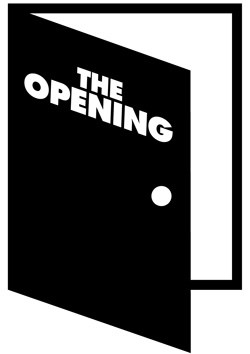
|
THE OPENING is all about introducing the fascinating, quirky and wonderful people working in and around the visual arts in Vancouver. Each week, we'll feature an artist, collective, curator or administrator to delve deep into who and what makes art happen! |
Everyone please welcome our new contributor, Ruth Skinner! Ruth hails from St. John's, Newfoundland, and came all the way to the other coast to study photography at Emily Carr University (BFA 2011). You can follow Ruth by her Tumblr, her website, or even on Twitter @rrrskins, though she isn't used to tweeting yet so we'll need to work together to coax her into it (she may harm me for saying that). For now, please enjoy her first offering, an interview with artist Bradley Harms.
----------------------
Bradley Harms (b. 1971, Winnipeg) uses the language of past painting traditions to address the contemporary cultural experience. Ever mindful of painting's many histories and -isms, Harms explores both the accord and antagonism between humans and technology. He is at the forefront of Canadian contemporary abstract painting, and has been exhibited widely both within Canada and internationally. Harms earned a BFA from the University of Calgary in 1996 and an MFA from the School of the Art Institute of Chicago in 2004. He recently met with me for drinks, and politely suffered having a recorder in his face for the better part of two hours.
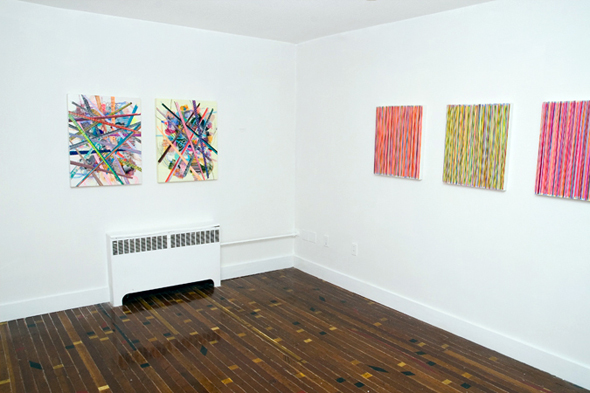
Installation view at Black & Yellow
How do you feel about your Black & Yellow show now that it's closing? It was a very crowded opening. I loved it, because I never actually had a show in the city. I've only been here for just bang-on a year now, and it did exactly what it needed to do. It got people familiar with my work. I'm sure people have been familiar with seeing me at openings, and I'm into discourse and dialogue, but no one ever knew what I did. I wanted to just have a little showcasing of the work, or forum, so people could get in front of these things.
Your current show, 'Total Confusion Fabulous', is in conjunction with another show in Toronto... It's at Angell, the gallery I show with in Toronto. The Vancouver show has seven pieces in it. The one at Angell had twenty-four.
For the Vancouver show, I had the Vancouver Paintings. They're called The Vancouver Paintings because when I first came here I was just starting to make these text paintings. I found that coming to a city that was steeped in conceptual work and conceptual photography, it gave me the perfect reason to incorporate text of a conceptual nature within the paintings. I find text in work very problematic and troublesome in that meaning is always skewed, and I didn't want to rely on semantic meaning. So it was the perfect kind of cheeky reason to make a text painting. This city is full of conceptual heavy-weights so I thought, let's just make a word-play out of their names which also gave me permission to make a text work that I didn't have to be overly careful with. It was playful right from the get-go.
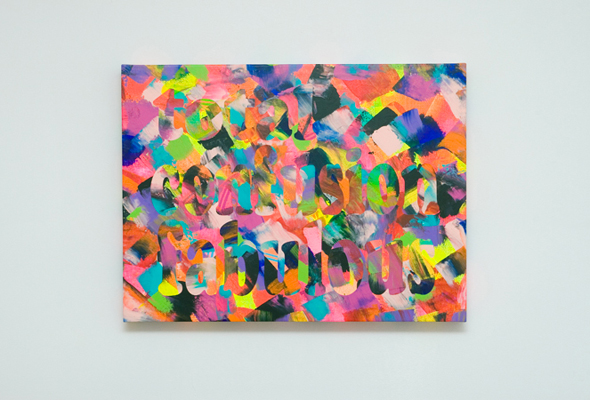
You must be pretty embroiled in this idea of the Vancouver art scene. Oh, I'm still confounded by it. I'm still struggling with what it means to make art in this city. Luckily I still have a studio in Calgary that I fly back to. I spend way more time in Vancouver, but every month and a half to two months I go back to Calgary for a couple of weeks to work in the studio there. But yeah, to be in this city, to make work is kind of daunting. The work that I've made here has only been shown in very sort of small situations and small increments. Subsequently everything I've done here has gone to other galleries in the country.
In terms of a gallery system, this city is pretty closed. That's what I'm still kind of parsing. In terms of a do-it-yourself position, it's amazing. That's what I love about this city. So I came here and I found brothers and sisters in arms, like thieves behind the gates.
People live it. People do live it. That's the perfect way to say it. They live the work. The whole commercial aspect of it, I don't really know yet. We'll see how it works out. I'm not necessarily even looking for a place to show in this city, because of the other [galleries]. All of my work is going somewhere, so it's a nice luxury to have, to just be able to be in the city and get a feel for it.
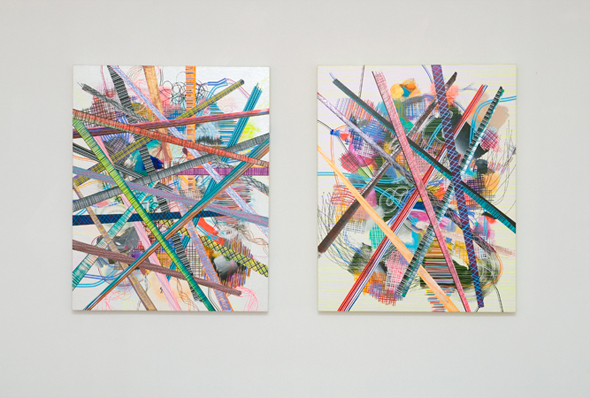
It's an incredibly complex and multi-layered arts system. You've got commercial galleries, you've got the artist-run centres, and basically that's what happens in Calgary. And Vancouver has another aspect that I experienced in Chicago. It's like the art-soldiers who do the mini shows in their bedroom closets. They'll do hotel shows. Black & Yellow is a perfect example of it. It shows how this culture has grown to embrace stuff like that.
I'm trying to figure out what I see in Vancouver. I see more energy than finished product, and that's kind of a weird thing. This is a breeding ground for creativity, but I don't think it's yet been realized. That's why it's got this do-it-yourself vibe. Everyone is doing something cool but we never really get to see the product, the realization of all the cool shit that people are doing here.
I know that you have a strong following in Calgary. And then I see you're placing yourself all over the country. It's not like you're basing yourself firmly in Vancouver. You're from Winnipeg originally. You studied in Calgary and then Chicago. You have a gallery representing you in Toronto... I think this city is great for conceptual heavy-weights but also heavy-weight international people. In having gone to school in the States, everybody at the School of the Art Institute of Chicago knew who Jeff Wall was. Nobody knew he was Canadian. It seems to me that as soon as somebody blows up and becomes international, at least in terms of the way that they're perceived, they shed their identity as a Canadian artist. And maybe that's just, 'well, we're all artists and there should be no national boundaries to it,' but I also feel a strong responsibility to show the work here, and show everywhere else as a secondary thing. If the work is good enough it will be international anyway. And if it does travel, I think that we're responsible for maintaining an identity for our work.
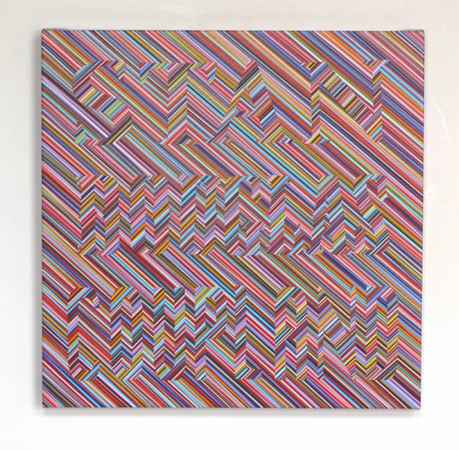
Stan Douglas Coupland
I was just in a show in LA, softcore HARD EDGE. It's a comparison of hard-edge painting between west-coast LA painters and painters in the region of Calgary, Alberta. It was curated by David Pagel, the critic for the LA Times, and Marianne Elder, who taught at the same school as Pagel. They both noticed this similarity between aesthetics, between abstract hard-edged paints and that kind of west-coast style. People are noticing that there's an international look to a lot of the work that's coming out of the west and the west coast, and I think it's bridging the two of them. Vancouver has never been compared in that way, and I think it will resist being compared in that way. But this city is full of abstract painters. The media just will not let you know it.
Who are some of the names that you're really excited about here in the city? Here in the city? I'd have to say Jessica Delorme. Erik Olson was here for the summer, and he's a spectacular painter. Ben Jacques just had a show at Shudder [with Justin Gradin]. That was pretty incredible. He's roommates with Justin Patterson. Justin is part of the Arbour Lake Sghool in Calgary. Justin and Ben are also Haunted Beard, an experimental noise band. These are just people that I know from showing up at openings and being there. And Ben Skinner. I went to school with him in Chicago.
Does Chicago focus in on one specific area? Schools are often known for their own preferred movements or styles. Chicago was completely indebted to the Imagists. That was the heavy-weight school of art-making there. But in having so many good schools very close by, I think Chicago benefited. Like, studio visits with Vanessa Beecroft and Jerry Saltz. This kind of access to art world A-listers was completely enriching, and good in terms of furthering our little student careers, our ideas and connections. I think that that's where Chicago succeeded as an art school. But as an art center, it is completely do-it-yourself. Michelle Grabner, who was one of my instructors and mentors, she ran a space called The Suburban, because she lived in Oak Park half an hour outside of Chicago. It was in her garage, a six foot by six foot room. She ran this gallery for years, and she had the likes of Luke Tuymans showing work in her space.
So this kind of do-it-yourself, get things done, show interesting things rather than consensus-driven good things was pervasive there. And I kind of feel that in Vancouver. A certain amount of people are going to get shown. That's not a knock against the system, but it's a fact that there are so few spaces to show in. I love to see all of these little places popping up, where really incredibly interesting things are happening. It enriches the rest of the community. You can go and see what the well-represented are doing, but then you can go and see what people are thinking about. They're not necessarily delivering the finished product, but sharing their ideas with one another.
Regarding your work, now. I'm interested in this idea of the sensual nature of your work, of your being 'the red-headed reactionist' to Modernism... When you first mention Modernism, I always feel conflicted about it. I'm definitely building on the Modernist ethos, but I'm also kind of... I don't want to say tearing it down, but I'm doing the opposite of what the Modernists wanted to do. Modernism concerned itself with purity, with the distillation of ideas. And what I'm concerned with is not distilling something down to it's essence, but building upon something until it becomes almost blindingly complex, which kind of creates its own minimalism or distillation by that. Instead of the subtractive nature of Modernism, there's the additive nature of culture as we know it—of speed culture and internet culture and culture of the screen. I take information and I build it up so that it vibrates in the same way that Minimalism vibrates. It is such a glut of information that it is so simple.
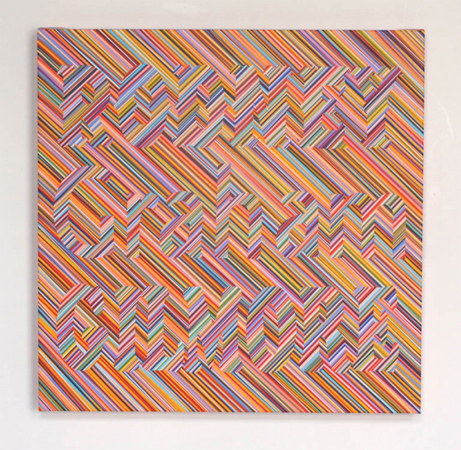
Rodney Graham Gillmore (orange)
My work revels in its ability to show the human hand, whereas digital art making (I call it CTRL-P Painting) doesn't show that at all. I love tricking the viewer, but I will never fully fool them. If they don't initially get it, they may think the paintings are digitally produced. And that's fine if they don't look far enough. My relationship with the viewer is a fleeting one, and I can only give them as much as they're willing to take. But if they're willing to go beyond that and see what's actually happening in front of their eyes, then it's super gratifying.
After reading a few reviews referring to how you are reacting against technology, it seemed a little off. If anything you would revel in this idea of limitless opportunity. I love what technology has made us see. What it has done is allow us to look at our world in a completely different way. We're a screen culture. We're a very superficial one, based on interface. A good thing about that is that we are delivered vast amounts of things. The bad thing is that we never actually go beyond that superficial read. That's where, to my practice, painting and art-making goes way beyond that superficial interface if you let it. If not, if you don't let it, then you're just reinforcing what I'm painting about.
You're not putting yourself in favour of one over the other? The fact is they exist at the same time and they exist as a commentary about one another, and each of those things can inform and comment on the other one without necessarily having to be better. I'm not going to stop technology. I'm not going to stop the internet. Facebook might. But I'm not going to.
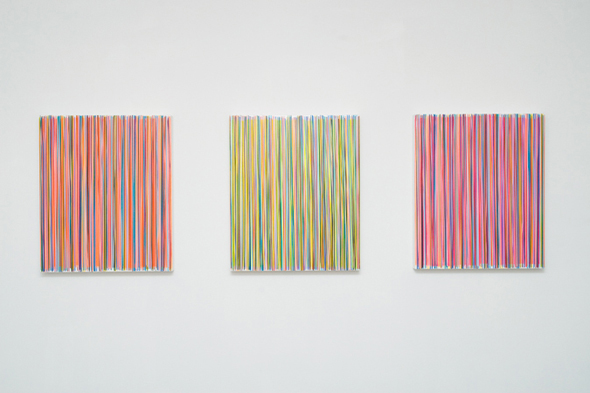
I'm very hesitant to pigeon-hole myself by picking an -ism and sticking to it. That's why I'm wary of even being associated with Modernism, because my work looks highly Modern, but it's about something completely different. I think that we need to find something that isn't related to language, that isn't related to previous movements, but that is completely related to what we like. Because we're in a culture where we get what we want and we get what we like. And what has given that to us is technology. We need a movement that is about information and misinformation, because while we get what we like, we don't always get the truth. And we don't always need to know the truth. All we need is information. I think about the next -ism as something that is just this build-up, this glut, of information. All of a sudden the pattern starts to make itself apparent, and you can read. You say, “This information actually starts to mean something.” I think that we're at the point where the glut doesn't mean anything yet. We're still parsing it.
So it looks like you're sticking in this vein for now? I'm still working on the text paintings. I'm just trying to use 'f*ck' a lot more.
-------------
'Total Confusion Fabulous' is showing at Black & Yellow gallery until October 15th. It is on in conjunction with 'Total Confusion Fabulous' at Angell Gallery in Toronto, which shows until October 29th. For more information, please visit his website at bradleyharms.com.
All photos courtesy Ruth Skinner and Bradley Harms


